
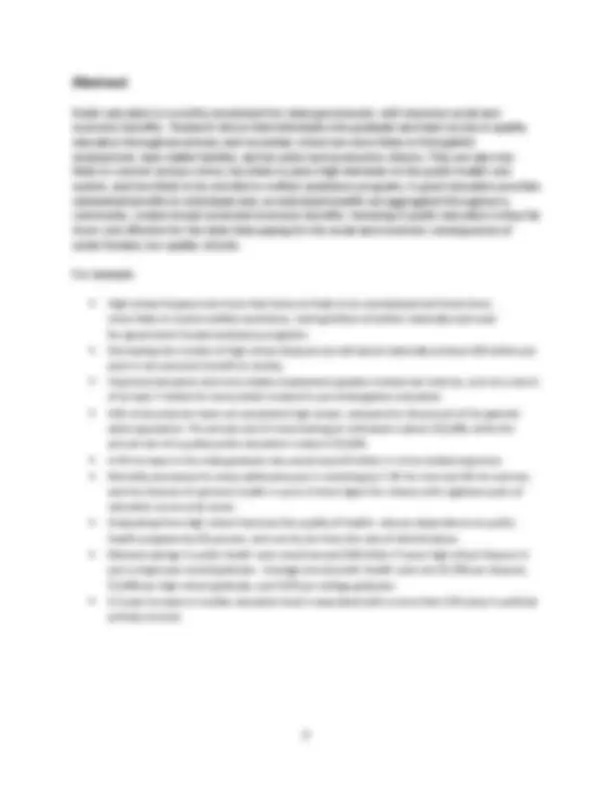
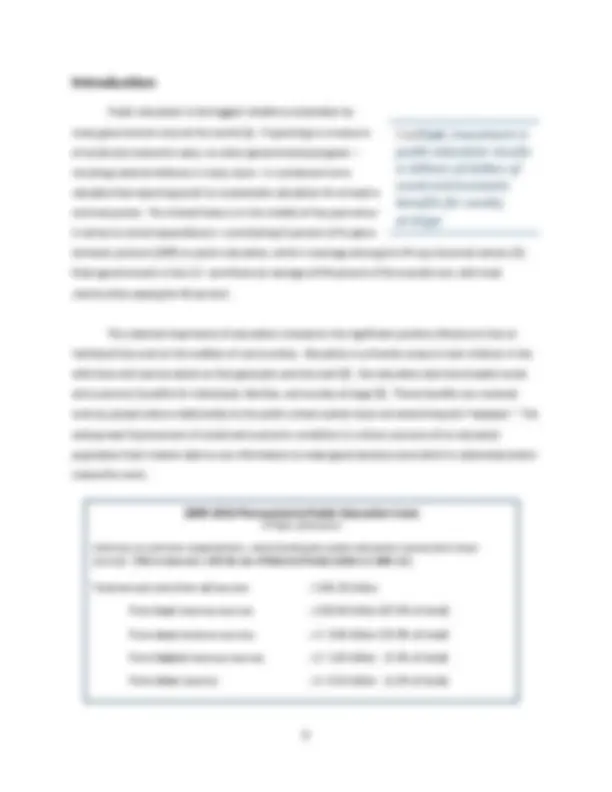
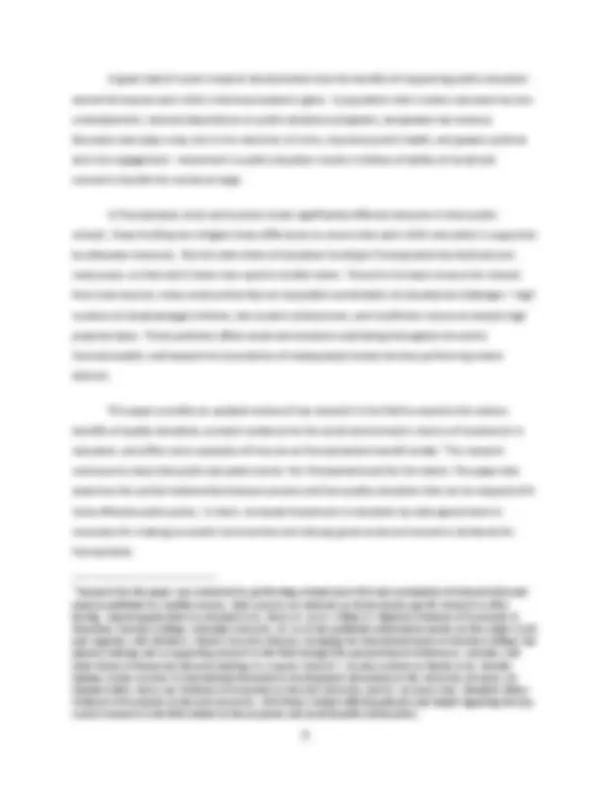
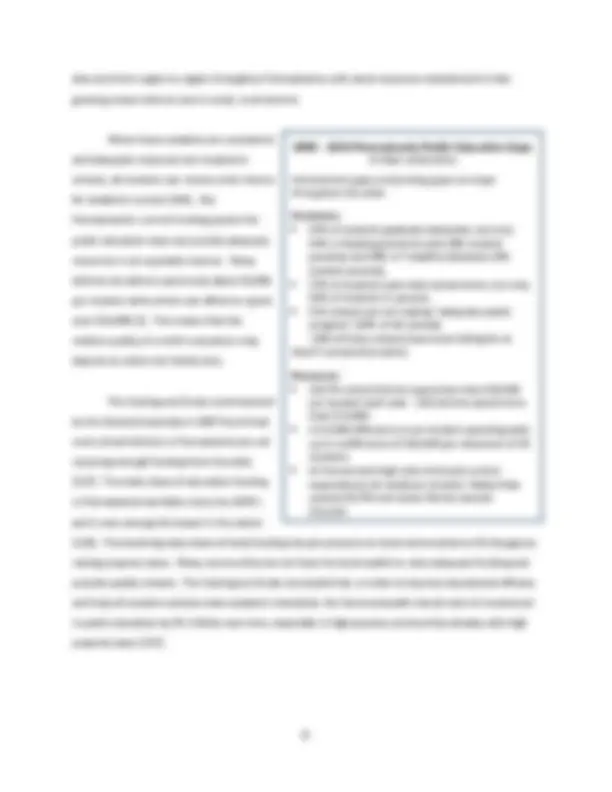
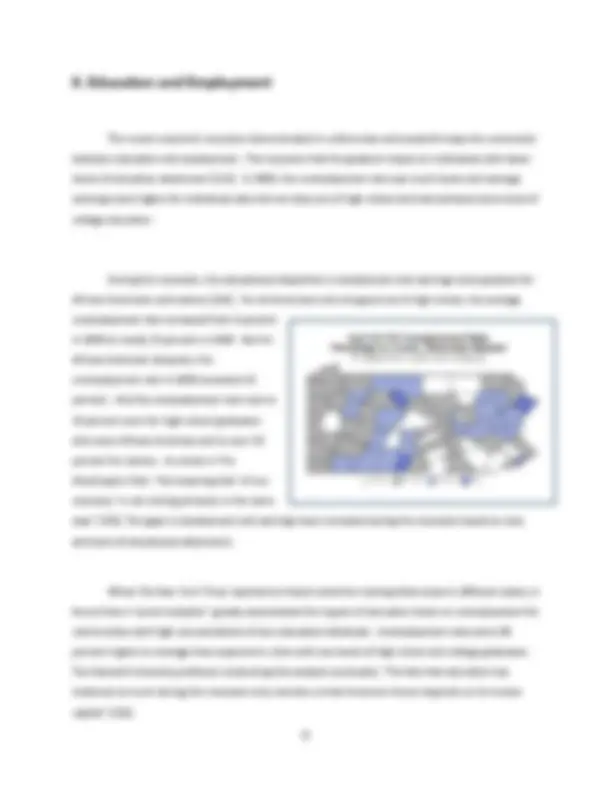
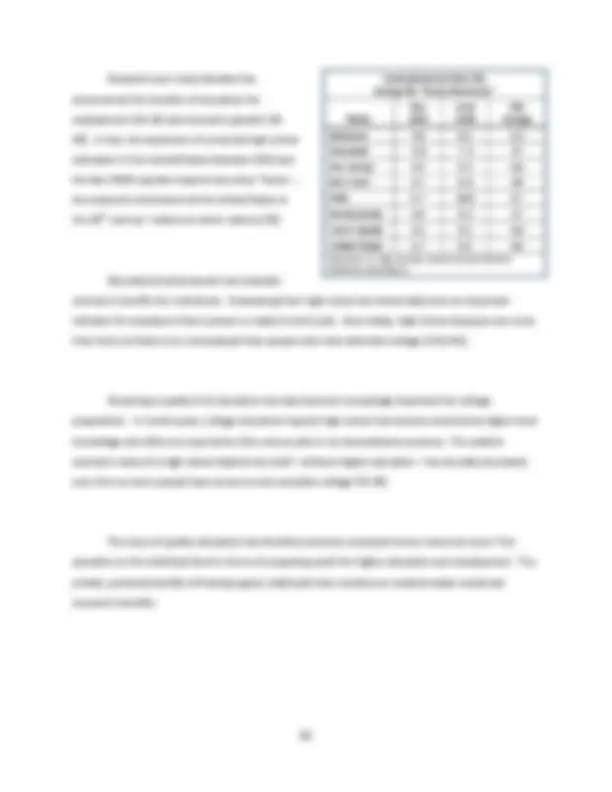
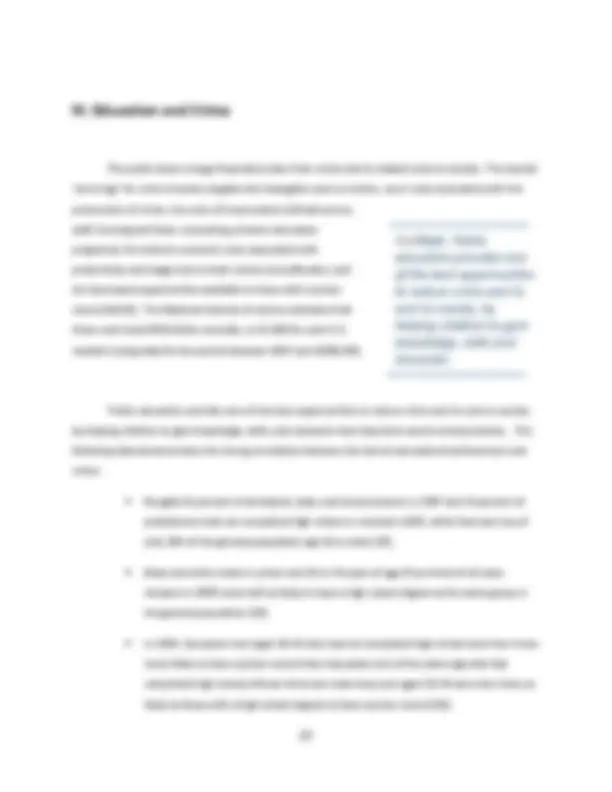
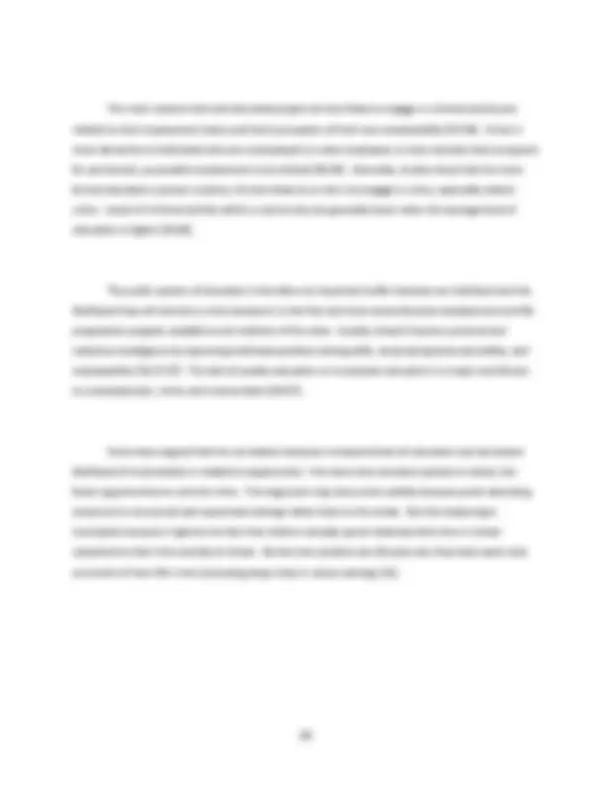
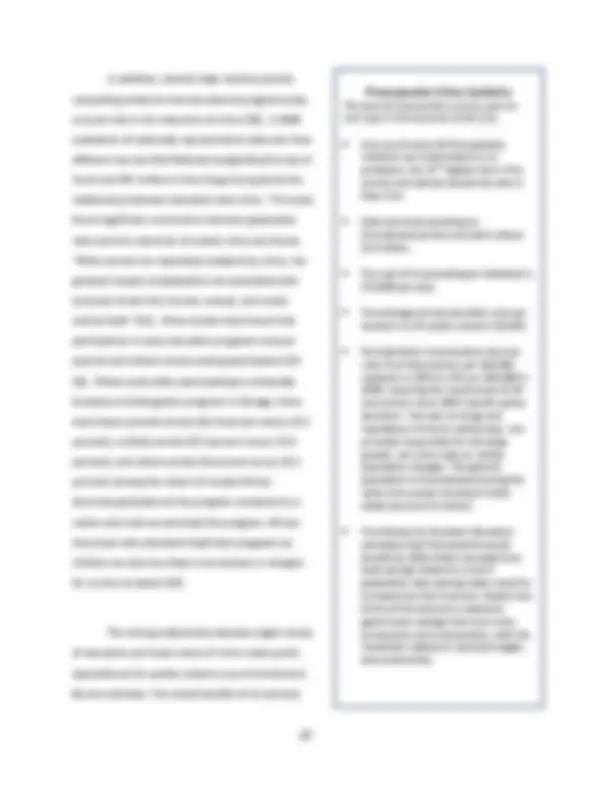
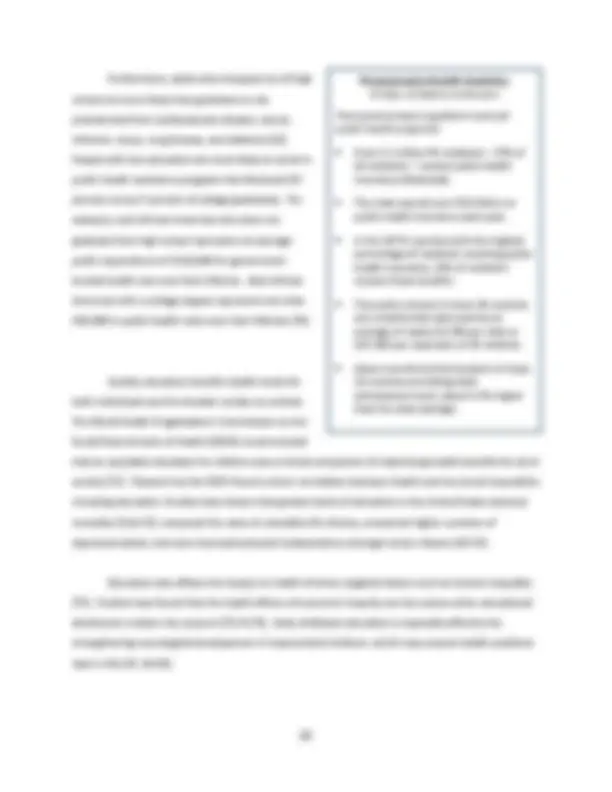
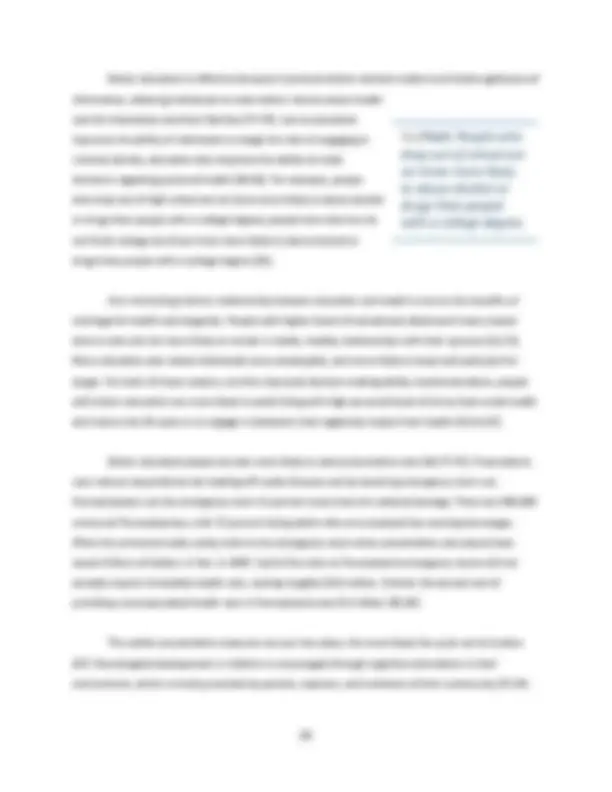
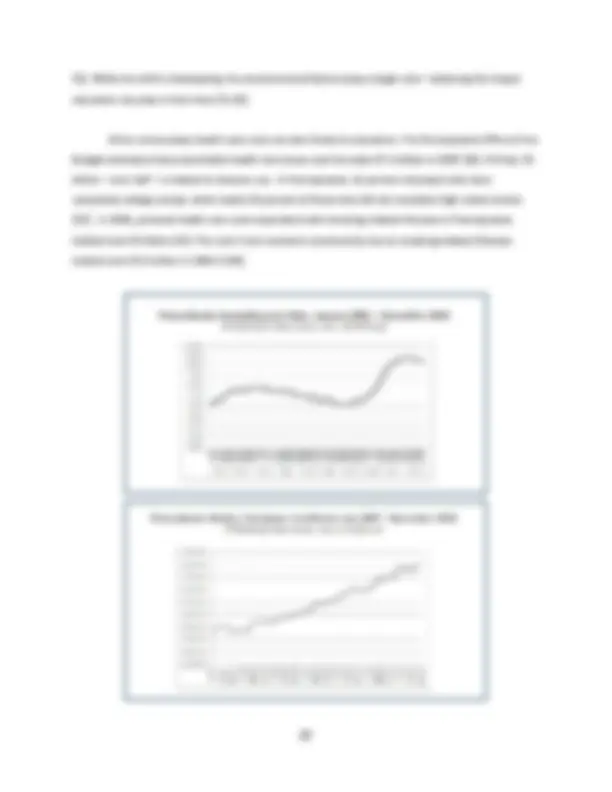

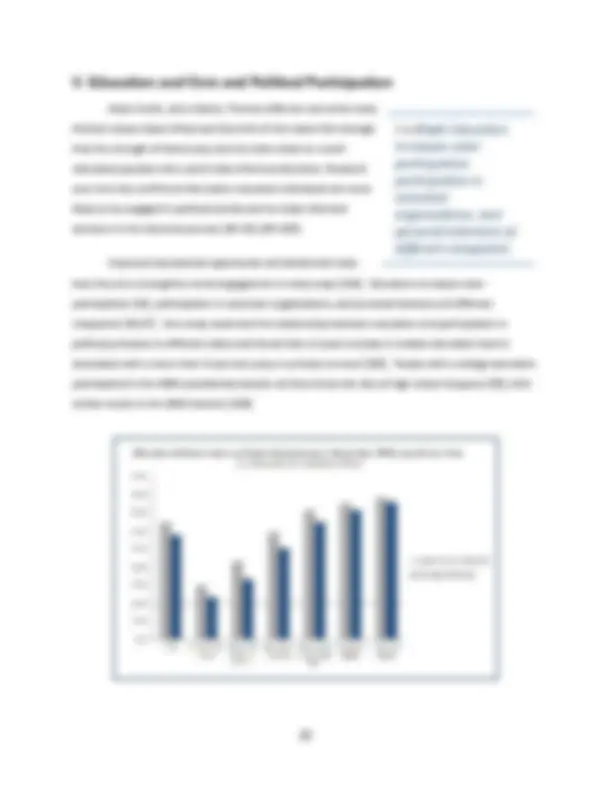
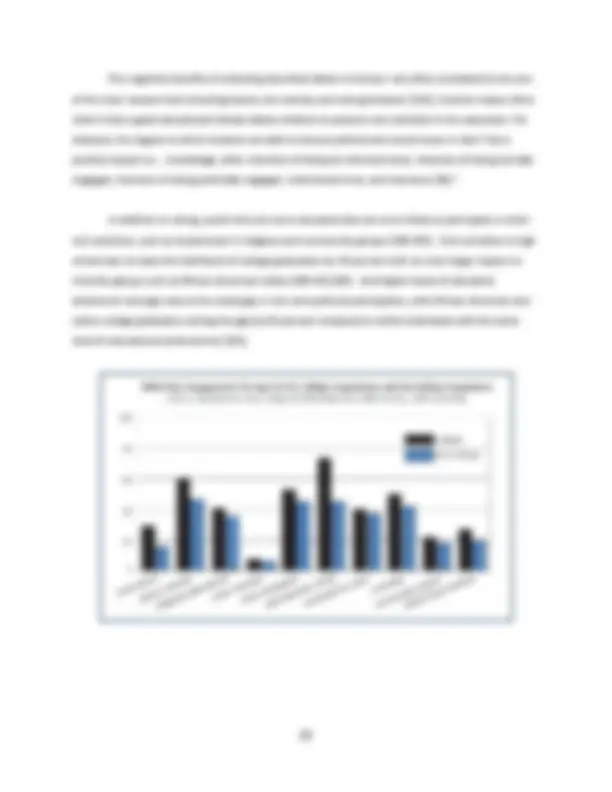
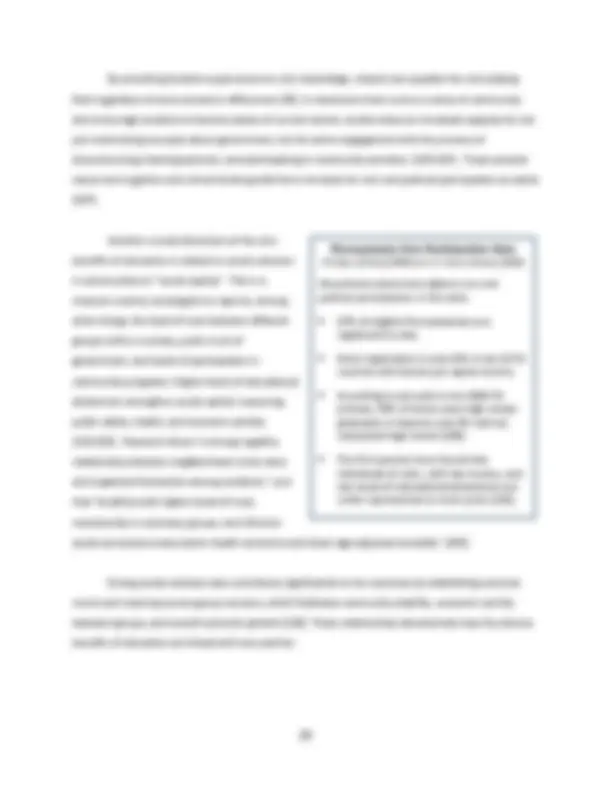
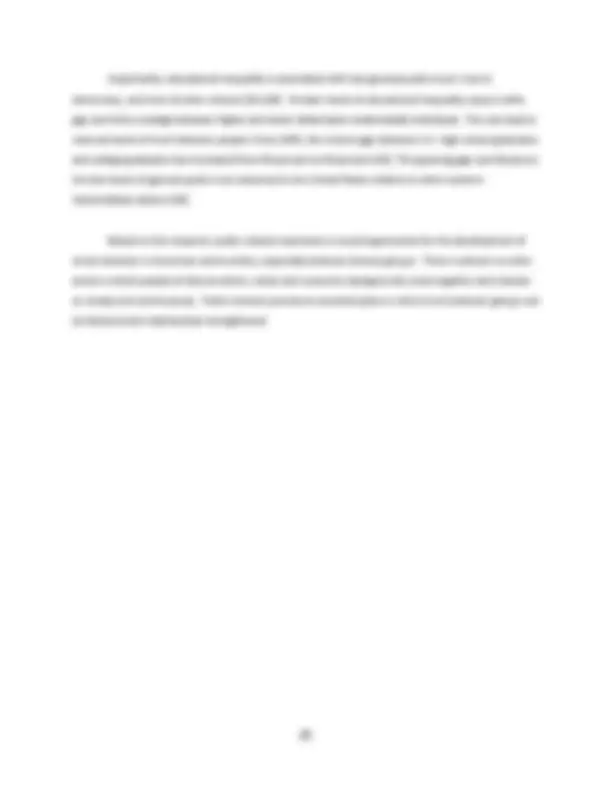
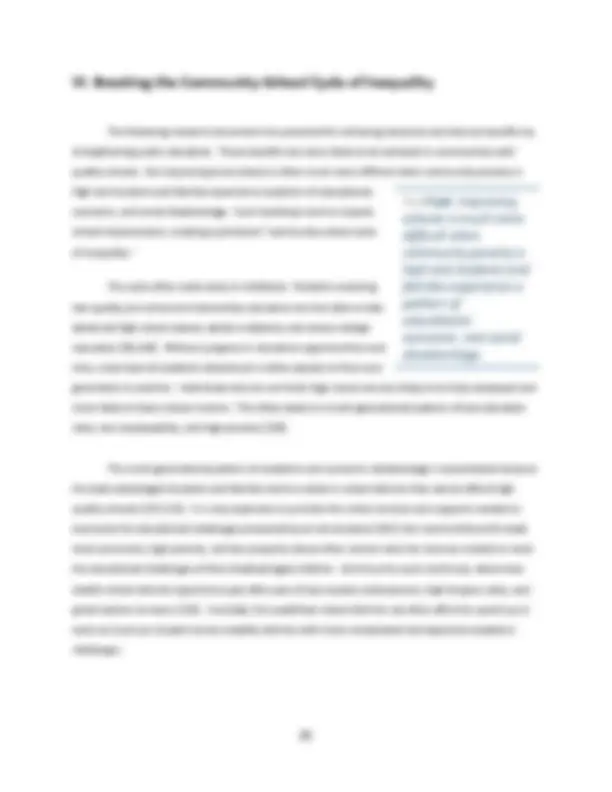
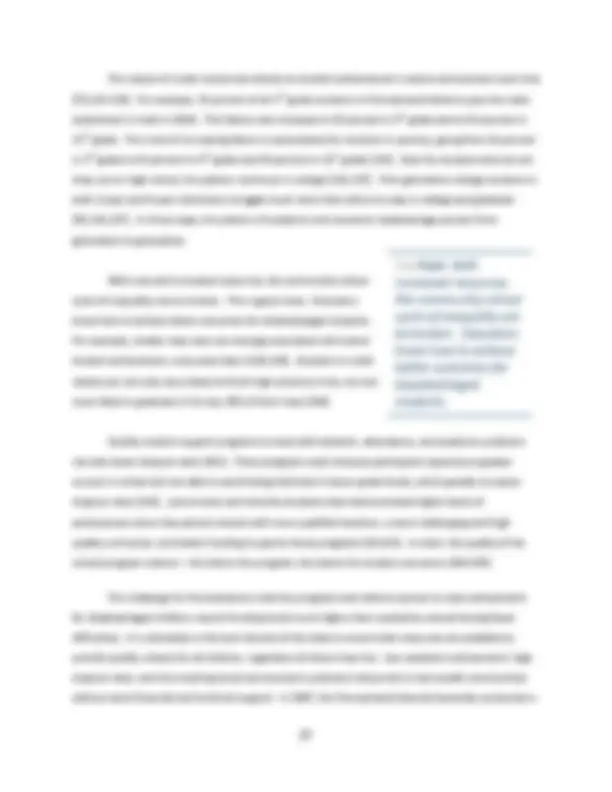
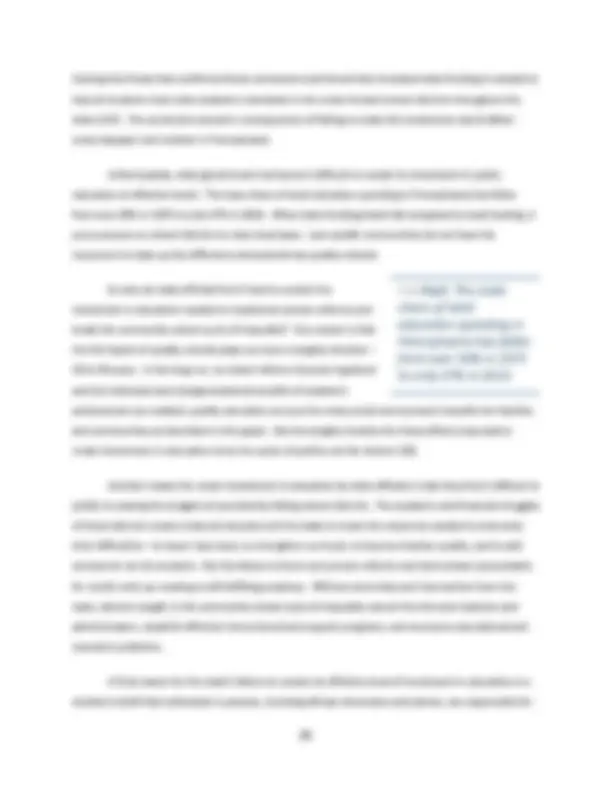
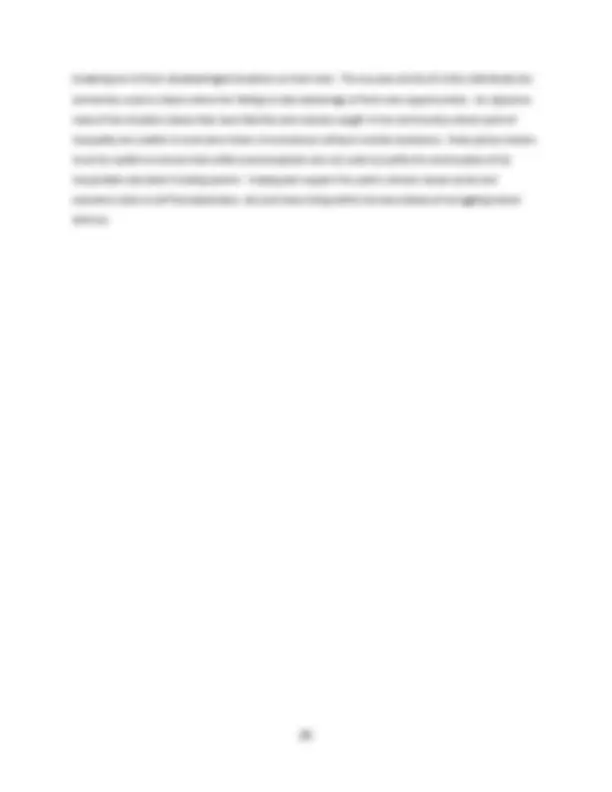
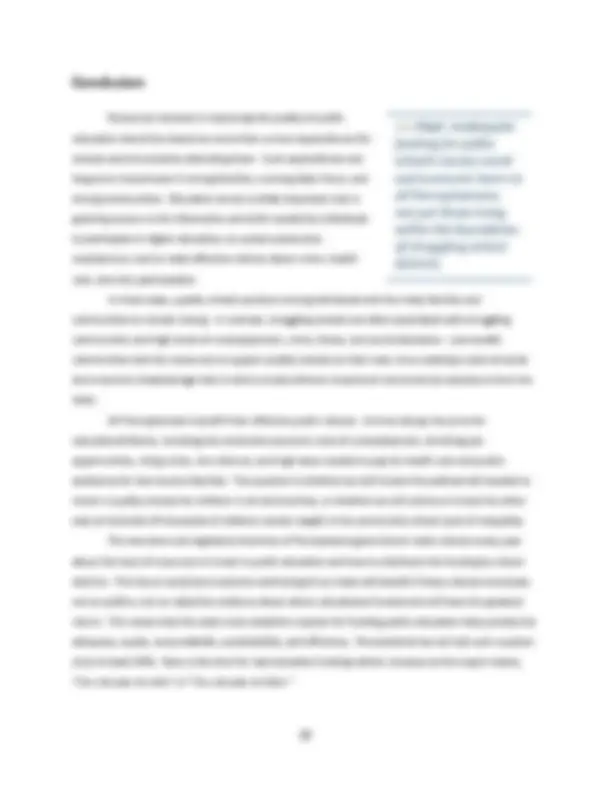
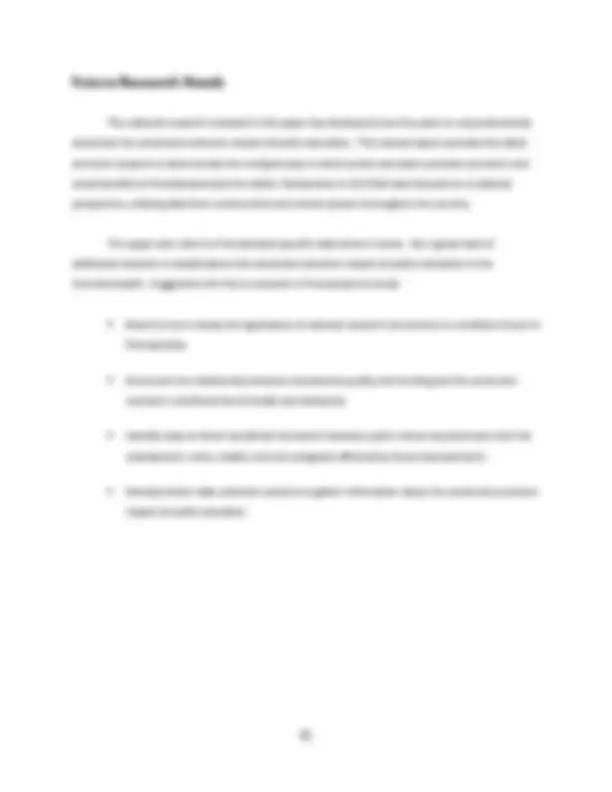

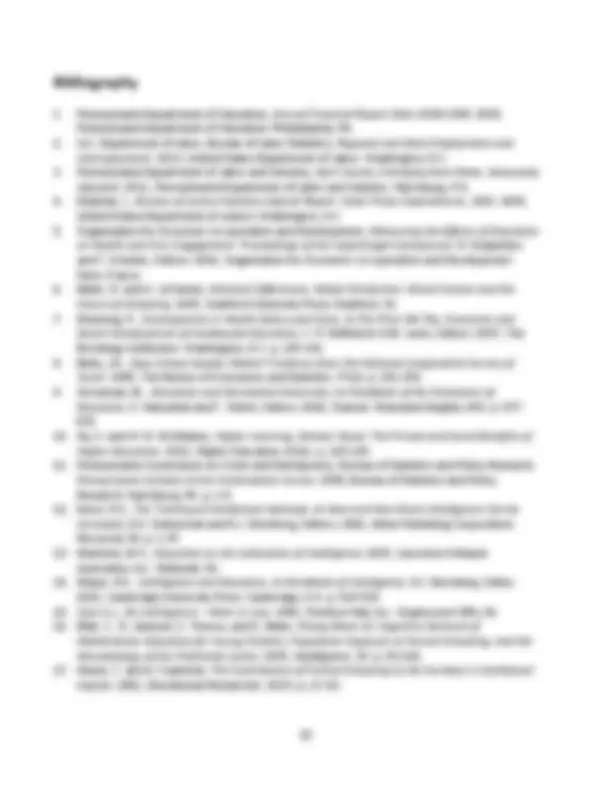
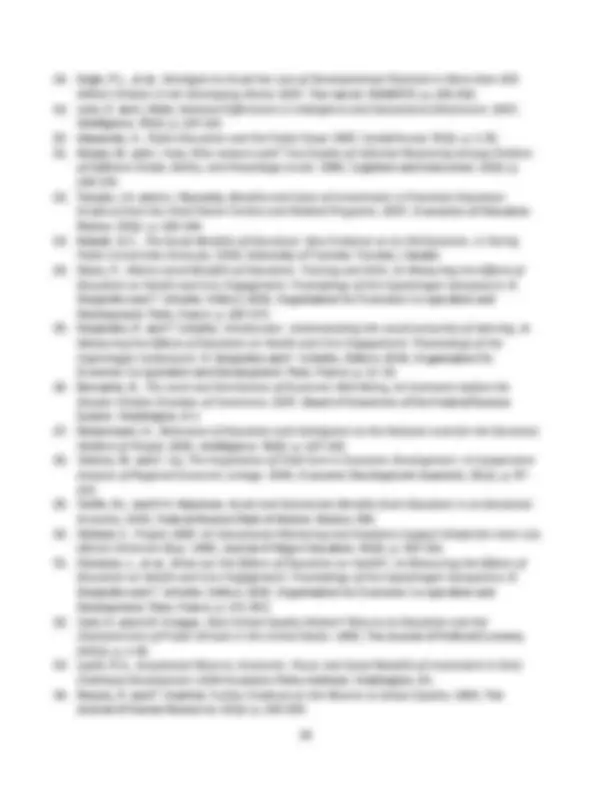
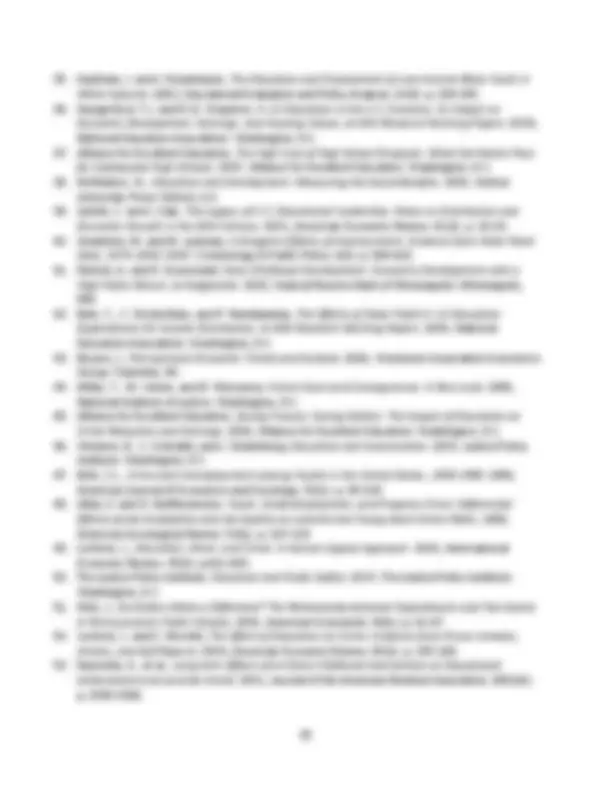
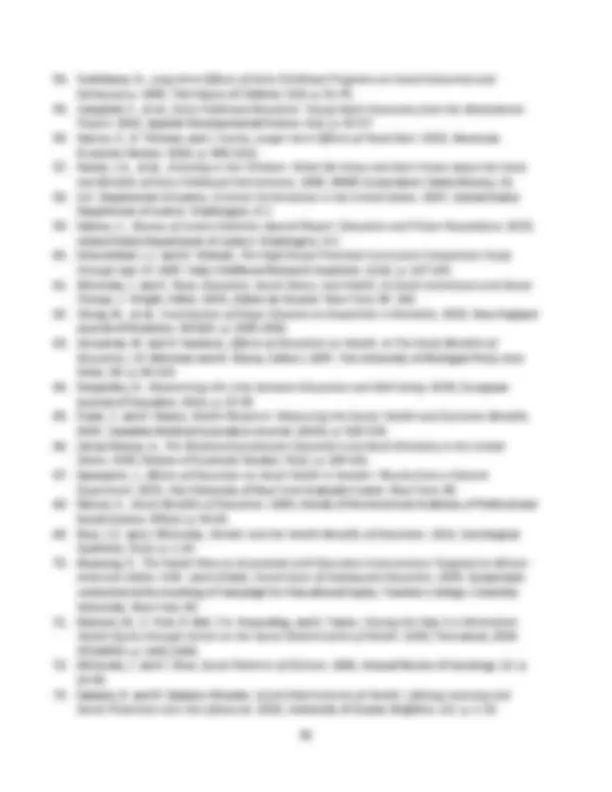
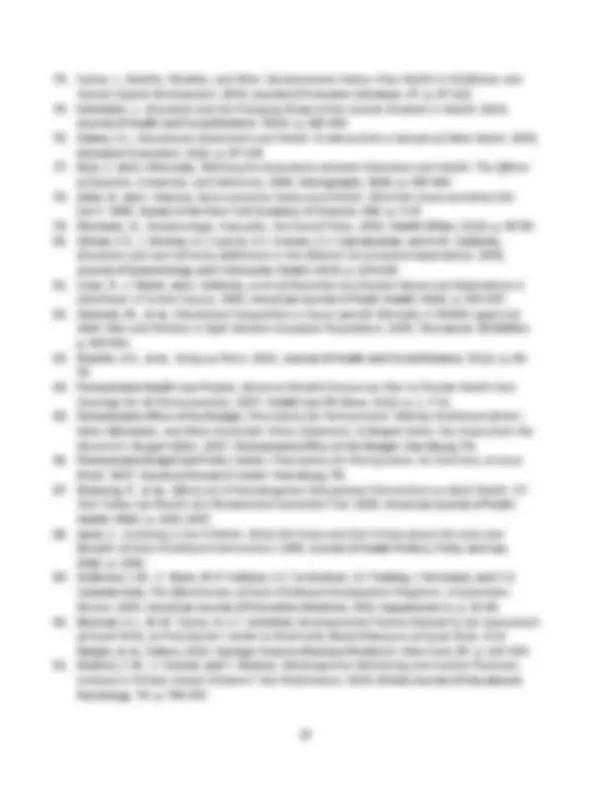
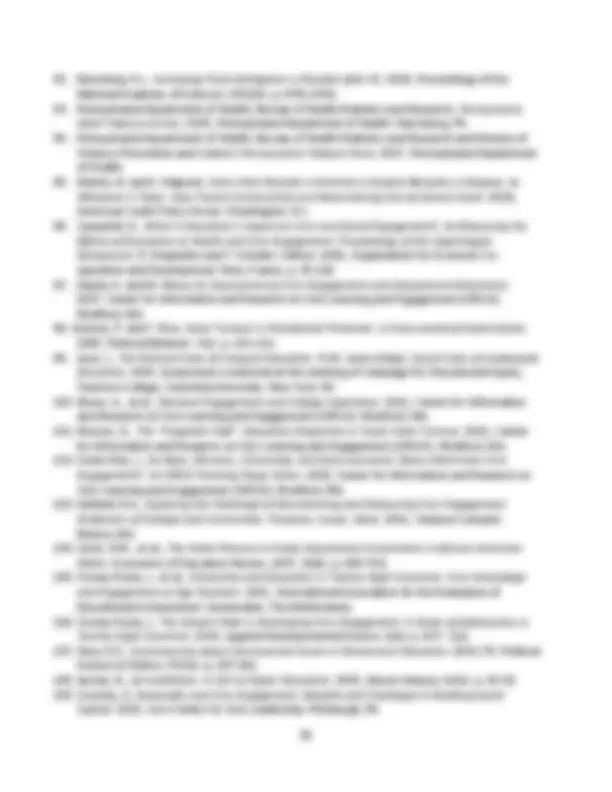
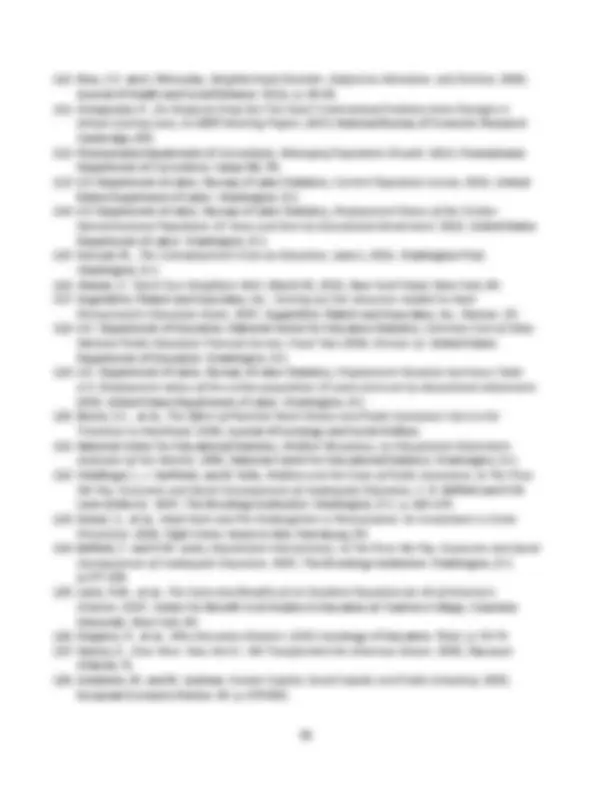
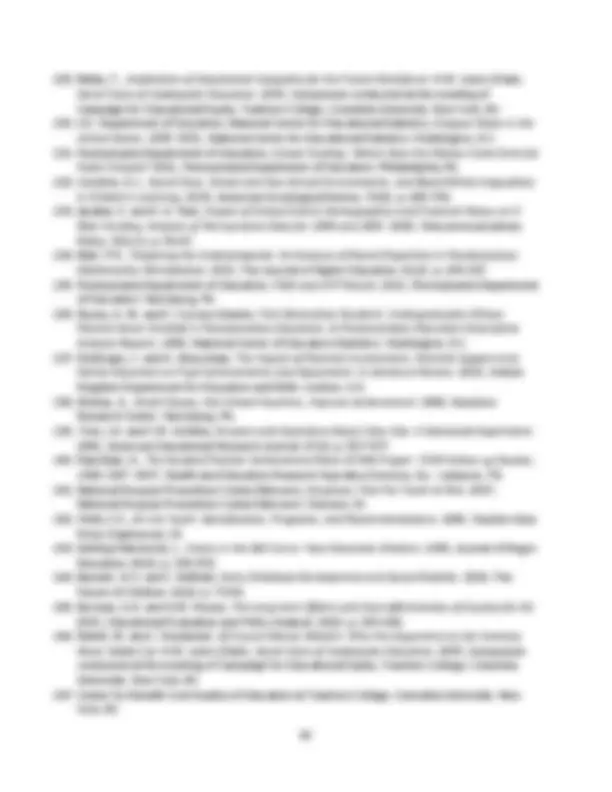
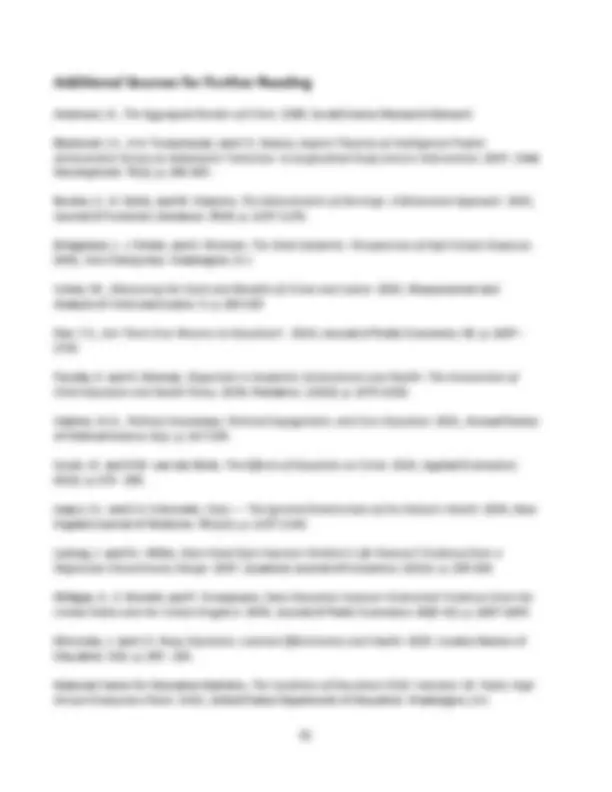



Study with the several resources on Docsity

Earn points by helping other students or get them with a premium plan


Prepare for your exams
Study with the several resources on Docsity

Earn points to download
Earn points by helping other students or get them with a premium plan
Community
Ask the community for help and clear up your study doubts
Discover the best universities in your country according to Docsity users
Free resources
Download our free guides on studying techniques, anxiety management strategies, and thesis advice from Docsity tutors
FastFact: The cognitive-intellectual gains that children and youth make in school contribute to the social and economic benefits derived from education for all.
Typology: Study notes
1 / 42

This page cannot be seen from the preview
Don't miss anything!



































PA Dept. of Education Contrary to common expectations, most funding for public education comes from local sources. [This is true even with the use of federal stimulus dollars in 2009-10.] Total annual costs from all sources = $26.15 billion From local revenue sources = $15.04 billion (57.5% of total) From state revenue sources = $ 8.86 billion (33.9% of total) From federal revenue sources = $ 1.92 billion (7.3% of total) From other sources = $ 0.33 billion (1.3% of total)
Introduction
Public education is the biggest initiative undertaken by many governments around the world [6]. If spending is a measure of social and economic value, no other governmental program – including national defense in many cases – is considered more valuable than exposing youth to a systematic education for at least a minimal period. The United States is in the middle of the pack when it comes to school expenditures—contributing 5 percent of its gross domestic product (GDP) to public education, which is average among the 34 top industrial nations [5]. State governments in the U.S. contribute an average of 48 percent of this overall cost, with local communities paying for 44 percent.
The national importance of education is based on the significant positive influence it has on individual lives and on the welfare of communities. Education is primarily a way to train children in the skills they will need as adults to find good jobs and live well [9]. But education also has broader social and economic benefits for individuals, families, and society at large [9]. These benefits are received even by people whose relationship to the public school system does not extend beyond “taxpayer.” The widespread improvement of social and economic conditions is a direct outcome of an educated population that is better able to use information to make good decisions and which is collectively better trained for work.
A great deal of recent research demonstrates how the benefits of supporting public education extend far beyond each child’s individual academic gains. A population that is better educated has less unemployment, reduced dependence on public assistance programs, and greater tax revenue. Education also plays a key role in the reduction of crime, improved public health, and greater political and civic engagement. Investment in public education results in billions of dollars of social and economic benefits for society at large.
In Pennsylvania, local communities invest significantly different amounts in their public schools. State funding can mitigate these differences to ensure that each child’s education is supported by adequate resources. But the state share of education funding in Pennsylvania has declined over many years, so that only 6 states now spend a smaller share. Forced to increase revenue for schools from local sources, many communities face an impossible combination of educational challenges – high numbers of disadvantaged children, low student achievement, and insufficient resources despite high property taxes. These problems affect social and economic well-being throughout the entire Commonwealth, well beyond the boundaries of inadequately funded and low performing school districts.
This paper provides an updated review of top research in the field to examine the various benefits of quality education, presents evidence for the social and economic returns of investment in education, and offers some examples of how we as Pennsylvanians benefit locally.^1 The research continues to show that public education works—for Pennsylvania and for the nation. The paper also examines the cyclical relationship between poverty and low-quality education that can be stopped with more effective public policy. In short, increased investment in education by state government is necessary for creating successful communities and will pay great social and economic dividends for Pennsylvania.
(^1) Research for this paper was conducted by performing a broad search for and examination of relevant data and analysis published by credible sources. Most sources are national, as Pennsylvania-specific research is often lacking. Special appreciation is extended to Dr. Henry M. Levin, William H. Kilpatrick Professor of Economics & Education, Teachers College, Columbia University. Dr. Levin has published authoritative books on this subject [124] and, together with Michael A. Rebell, Executive Director, Campaign for Educational Equity at Teachers College, has played a leading role in supporting research in the field through the sponsorship of conferences, websites, and other forms of interaction between leading U.S. experts [146,147]. We also extend our thanks to Dr. Ricardo Sabates, Senior Lecturer in International Education & Development (Education) at the University of Sussex; Dr. Claudia Goldin, Henry Lee Professor of Economics at Harvard University; and Dr. Lawrence Katz, Elisabeth Allison Professor of Economics at Harvard University. All of these scholars offered guidance and insight regarding the top current research in the field related to the economic and social benefits of education.
The cumulative impact of these educational benefits helps individuals to have more options for and to make better decisions about their lives. Improved options and decision-making includes better choices about work, better risk assessment concerning deviant or criminal behavior, and better personal health choices. Thus, the cognitive-intellectual gains that children and youth make in school contribute to the social and economic benefits derived from education for all members of society.
There are other “spillover” effects from education that transform individual gains into social gains. The personal, individual benefits of a good education have broad benefits for society when improved “human capital” capacity – personal knowledge, skills, and judgment – is taken by the individual into the workplace, the public square, and the home [23-28]. For example, all of society benefits when more people are able to find adequate and stable employment. A better educated work force not only leads to more research and innovation, but the benefits of this economic innovation are then spread more widely and powerfully throughout a better educated public [29]. Everyone also benefits when fewer citizens experience alienation or general distrust of others and government. And the children of well-educated parents are less likely to seek public assistance, even when eligible [29]. Each of these examples is directly related to receiving a quality education.
In short, effective education improves decision-making abilities that then help individuals stay out of trouble and live better, healthier, and longer lives. As economist Milton Friedman wrote, “the education of my child contributes to other people’s welfare by promoting a stable and democratic society” *23+. Governments in America and in other countries have adopted this approach and invested heavily in education as an institution with significant responsibility both for individual child development and broader social and economic welfare [30,31]. Despite the many challenges that public education faces, it is an effective way to prepare large numbers of youth for their own future and for the overall welfare of society [125].
Given the overall efficacy of education, it is also important to determine the level of resources needed to maximize student achievement and the quality of teaching and learning that takes place in any given school. Research has consistently shown that student achievement benefits from small class sizes, qualified teachers, safe school environments, and up-to-date instructional materials and technology [146]. These things cost money, as do the additional programs and services needed for students with disabilities, English language learners, and children living in poverty [117]. Education costs
PA Dept. of Education Achievement gaps and funding gaps are large throughout the state. Outcomes: 83% of students graduate statewide, but only 54% in Reading (a district with 90% student poverty) and 99% in Tredyffrin-Easttown (4% student poverty). 72% of students pass state assessments, but only 56% of students in poverty. 536 schools are not making “adequate yearly progress” (25% of all schools). (194 of these schools have been failing for at least 4 consecutive years.) Resources: 102 PA school districts spend less than $10, per student each year. 130 districts spend more than $13,000. A $2,500 difference in per student spending adds up to a difference of $62,500 per classroom of 25 students. At the low and high ends of annual current expenditures (in total) per student, Valley View spends $8,781 and Lower Merion spends $23,115.
also vary from region to region throughout Pennsylvania, with extra resources needed both in fast growing school districts and in small, rural districts.
When these variables are considered and adequate resources are invested in schools, all students can receive a fair chance for academic success [146]. But Pennsylvania’s current funding system for public education does not provide adequate resources in an equitable manner. Many districts are able to spend only about $8, per student while others can afford to spend over $18,000 [1]. This means that the relative quality of a child’s education may depend on where her family lives.
The Costing-out Study commissioned by the General Assembly in 2007 found that most school districts in Pennsylvania are not receiving enough funding from the state [117]. The state share of education funding in Pennsylvania has fallen since the 1970’s and is now among the lowest in the nation [118]. The declining state share of total funding has put pressure on local communities to fill the gap by raising property taxes. Many communities do not have the local wealth to raise adequate funding and provide quality schools. The Costing-out Study concluded that, in order to improve educational efficacy and help all students achieve state academic standards, the Commonwealth should raise its investment in public education by $4.3 billion over time, especially in high-poverty communities already with high property taxes [117].
Research over many decades has documented the benefits of education for employment [32-36] and economic growth [36- 40]. In fact, the expansion of universal high school education in the United States between 1915 and the late 1950s explains beyond any other “factor … the economic dominance of the United States in the 20th^ century” relative to other nations *39+.
Educational achievement has dramatic economic benefits for individuals. Graduating from high school has historically been an important indicator for employers that a person is ready to hold a job. Even today, high school dropouts are more than twice as likely to be unemployed than people who have attended college [119,141].
Receiving a quality K-12 education has also become increasingly important for college preparation. In recent years, college education beyond high school has become essential as higher level knowledge and skills are required by 21st century jobs in an international economy. The relative economic value of a high school diploma by itself – without higher education – has actually decreased over time as more people have access to and complete college [32,39].
The issue of quality education has therefore become a societal human resources issue. This operates on the individual level in terms of preparing youth for higher education and employment. The private, personal benefits of having a good, stable job then combine to create broader social and economic benefits.
Unemployment Rate (%) during the “Great Recession” State
Dec. 2007
June 2009
Net change Delaware 3.9 8.1 4. Maryland 3.6 7.3 3. New Jersey 4.5 9.3 4. New York 4.7 8.6 3. Ohio 5.7 10.4 4. Pennsylvania 4.5 8.2 3. West Virginia 4.1 8.1 4. United States 4.7 9.5 4. Data from U.S. Dept. of Labor, Bureau of Labor Statistics (seasonally adjusted) [2]
For example, employment is linked to better health because most Americans gain access to health insurance through their employer. The health benefits of education also occur because better educated people tend to have more stable employment, which reduces life stressors and risk factors that negatively affect health. More stable employment is linked to reduced likelihood of committing crime and reduced need for public assistance programs supported by tax revenue [26,70]. Because dropouts have so many fewer employment opportunities, the ripple effect of their disadvantage costs the nation billions of dollars in lost tax revenue and in welfare, unemployment, and crime prevention programs [111].
Government support for public education is thus crucial for individual employment, the broad creation of human capital, and overall economic growth [23,26,41,74,128]. Policies that boost government investment in education can help reduce income inequality while expanding economic opportunity [26]. States that invest more in public education eventually reduce levels of income inequality between residents [42]. One report predicts that economic growth will continue to be uneven in Pennsylvania because of local differences in educational opportunity [43].
Reduced government expenditures for welfare programs are a powerful example of the significant employment and economic benefits of quality education. Participation in cash assistance programs is highest among individuals with the lowest levels of education [120-122]. In 1992, high school dropouts were three times more likely to receive income from public assistance than high school graduates who did not go on to college – 17 percent versus 6 percent [121]. Between 1972 and 1992, both high school dropouts and graduates who did not go on to college were more likely to receive public assistance [121].
III. Education and Crime
The public bears a huge financial burden from crime and its related costs to society. The overall “price tag” for crime includes tangible and intangible costs to victims, court costs associated with the prosecution of crime, the costs of incarceration (infrastructure, staff, housing and food, counseling, prisoner education programs), the indirect economic costs associated with productivity and wages lost to both victims and offenders, and the decreased opportunities available to those with a prison record [48,49]. The National Institute of Justice estimates that these costs total $450 billion annually, or $1,800 for each U.S. resident (using data for the period between 1987 and 1990) [44].
Public education provides one of the best opportunities to reduce crime and its cost to society by helping children to gain knowledge, skills, and character that help them avoid criminal activity. The following data demonstrates the strong correlation between the lack of educational achievement and crime:
Roughly 41 percent of all federal, state, and local prisoners in 1997 and 31 percent of probationers had not completed high school or received a GED, while that was true of only 18% of the general population age 18 or older [59].
Black and white males in prison and 20 to 39 years of age (Two-thirds of all state inmates in 1997) were half as likely to have a high school degree as the same group in the general population [59].
In 1999, Caucasian men aged 30-34 who had not completed high school were four times more likely to have a prison record than Caucasian men of the same age who had completed high school; African American male drop outs aged 30-34 were two times as likely as those with a high school degree to have a prison record [46].
The main reasons that well-educated people are less likely to engage in criminal activity are related to their employment status and their perception of their own employability [47,48]. Crime is more attractive to individuals who are unemployed or under-employed, or who consider their prospects for permanent, purposeful employment to be limited [48,49]. Generally, studies show that the more formal education a person receives, the less likely he or she is to engage in crime, especially violent crime. Levels of criminal activity within a community are generally lower when the average level of education is higher [29,50].
The public system of education is therefore an important buffer between an individual and the likelihood they will commit a crime because it is the first and most comprehensive employment and life preparation program available to all residents of the state. Quality schools improve personal and collective intelligence by improving individual problem solving skills, social perspective and ability, and employability [16,17,27]. The lack of quality education or incomplete education is a major contributor to unemployment, crime, and incarceration [49,57].
Some have argued that the correlation between increased levels of education and decreased likelihood of incarceration is related to opportunity – the more time someone spends in school, the fewer opportunities to commit crime. This argument may have some validity because youth attending school are in structured and supervised settings rather than on the street. But this reasoning is incomplete because it ignores the fact that children actually spend relatively little time in school compared to their time outside of school. By the time students are 18 years old, they have spent only one-tenth of their life’s time (including sleep time) in school settings *51].
increase in male U.S. high school graduation rates (from reduced crime alone) would have amounted to $1.4 billion” *52+. An average savings of $26,600 related to criminal justice would be realized over the lifetime of each additional high school graduate [125]. Authors of a study examining the long-term effects of the Perry Pre-School program in Michigan estimate that the program’s effectiveness in reducing crime, as well as participation in welfare and other social programs, produced the equivalent of $17 in savings to taxpayers for every one dollar spent (including $11 in crime costs alone) [60].
The nation currently spends on average over $13,000 more annually per inmate than per student. In 2004 the United States spent almost $50 billion in incarceration costs [45]. Investing in public education in the short term should result in increased graduation rates over the long term and less need to spend public resources on crime prevention and incarceration.
IV. Education and Health
Imagine going to the doctor and being told about a medication that would add years to your life and add quality to those years. If everyone took the full course of this medication, it could even reduce the public tax burden and improve community well-being. There is such medicine, but it’s not a pill – education leads to these beneficial results.
People with higher levels of education tend to live longer, healthier lives and depend less on government-funded health programs than people with less education [62-66]. Researchers have found that learning promotes a sense of control in lifestyle choices in individuals that enriches their lives on multiple levels, and improves health as a direct result. In the United States, each additional year of education reduces the risk of death in the next decade by 3.6 percent [5], and in Sweden, research has shown that the risk of bad health is lowered by over 18 percent with an another year of education [67].
Studies have found the following positive benefits of education for personal health [31]:
People with more education are more likely to have healthy diets and exercise frequently, and are less likely to smoke, be obese, or engage in binge drinking. For U.S. women, enrolling in college and staying for at least two years reduces their likelihood of smoking during pregnancy. Improved educational opportunity for U.S. women decreased the probability of pre-term births by 20 percent and low birth-weight by 12 percent between 1940 and 1980. As high school graduation rates doubled for white Americans and tripled for African Americans between 1960 and 1990, infant mortality for both groups decreased [68].
Better education is effective because it produces better decision-makers and better gatherers of information, allowing individuals to make better choices about health care for themselves and their families [77-79]. Just as education improves the ability of individuals to weigh the risks of engaging in criminal activity, education also improves the ability to make decisions regarding personal health [80-86]. For example, people who drop out of high school are six times more likely to abuse alcohol or drugs than people with a college degree; people who start but do not finish college are three times more likely to abuse alcohol or drugs than people with a college degree [81].
One interesting indirect relationship between education and health is due to the benefits of marriage for health and longevity. People with higher levels of educational attainment have a lower divorce rate and are more likely to remain in stable, healthy relationships with their spouses [61,72]. More education also makes individuals more employable, and more likely to keep well-paid jobs for longer. For both of these reasons, and the improved decision-making ability mentioned above, people with better education are more likely to avoid living with high personal levels of stress that erode health and reduce the life span or to engage in behaviors that negatively impact their health [25,61,67].
Better educated people are also more likely to seek preventative care [60,77-79]. Preventative care reduces expenditures by heading off costly illnesses and by lowering emergency room use. Pennsylvanians use the emergency room 11 percent more than the national average. There are 900, uninsured Pennsylvanians, with 71 percent being adults who are employed but earning low-wages. Often the uninsured make costly visits to the emergency room when preventative care would have saved millions of dollars. In fact, in 2007, half of the visits to Pennsylvania emergency rooms did not actually require immediate health care, costing roughly $232 million. Overall, the annual cost of providing uncompensated health care in Pennsylvania was $1.4 billion [85,86].
The earlier preventative measures are put into place, the more likely the cycle can be broken [87]. Neurological development in children is encouraged through cognitive stimulation in their environment, which is mostly provided by parents, teachers, and members of their community [57,88-
91]. While the child is developing, the environmental factors play a larger role—widening the impact education can play in their lives [71,92].
Other unnecessary health care costs are also linked to education. The Pennsylvania Office of the Budget estimates that preventable health care issues cost the state $7.6 billion in 2007 [85]. Of that, $ billion – over half – is related to tobacco use. In Pennsylvania, 12 percent of people who have completed college smoke, while nearly 29 percent of those who did not complete high school smoke [93]. In 1998, personal health care costs associated with smoking-related illnesses in Pennsylvania totaled over $4 billion [93]. The cost in lost economic productivity due to smoking-related illnesses totaled over $4.5 billion in 2002-3 [94].